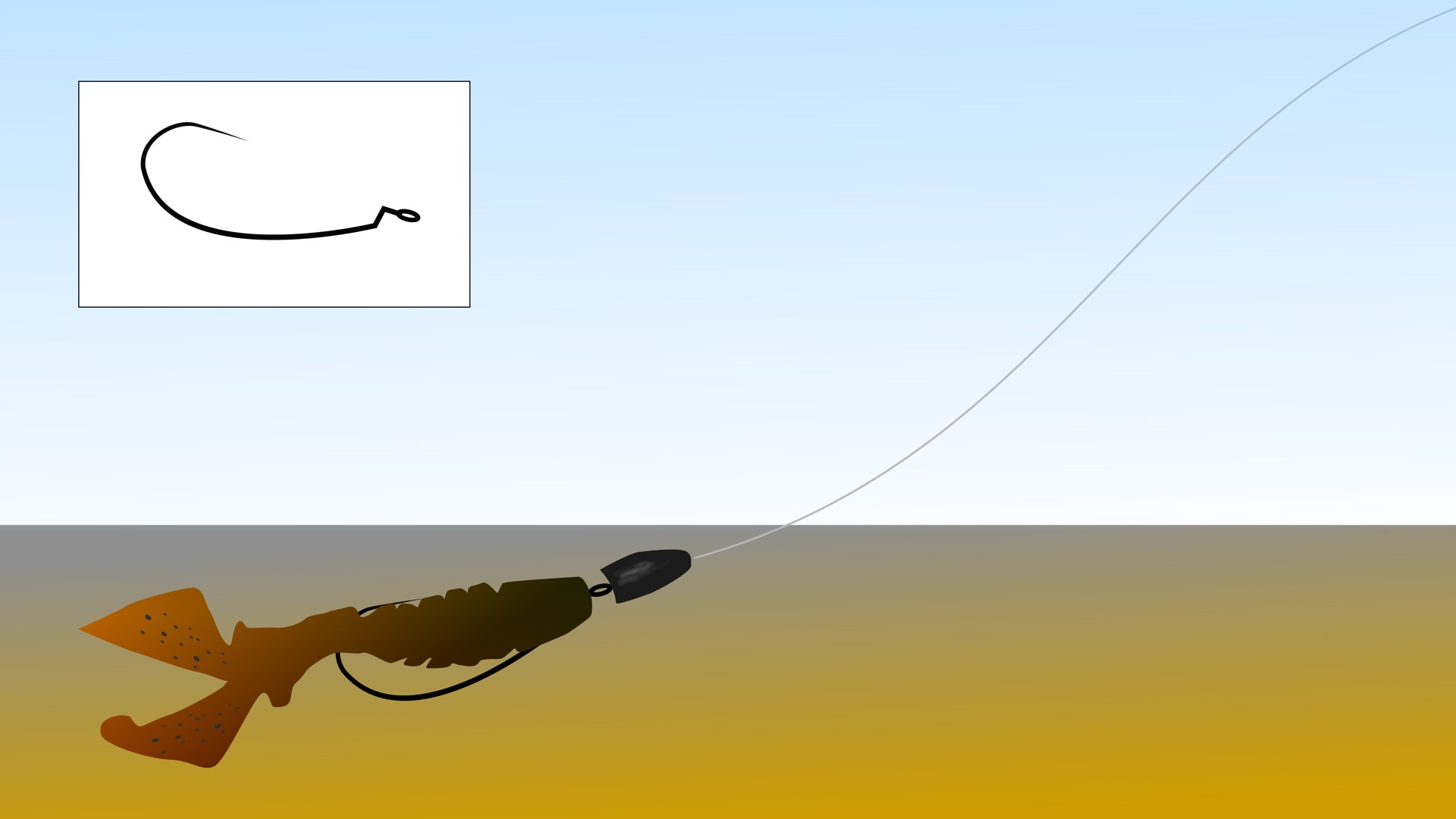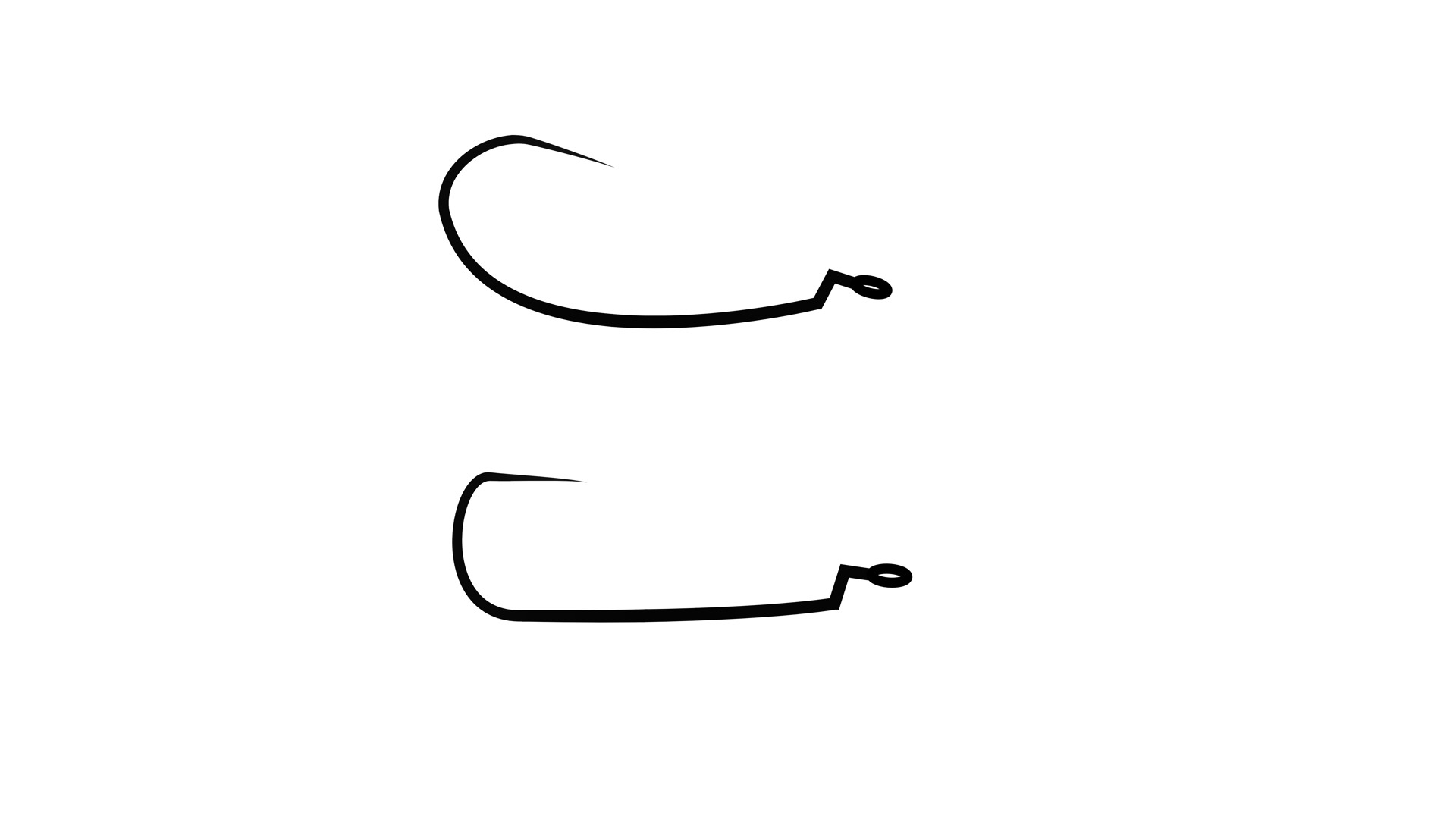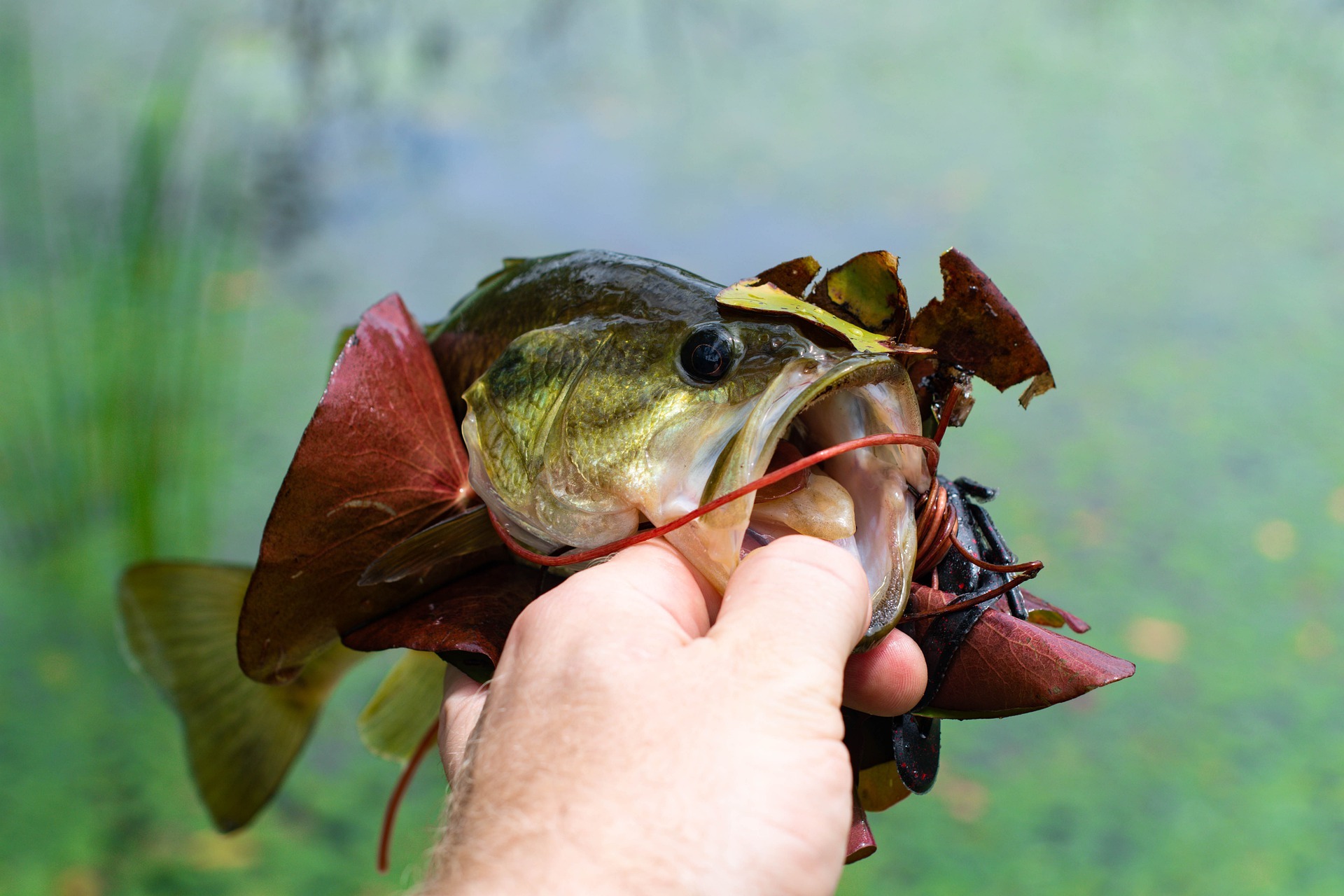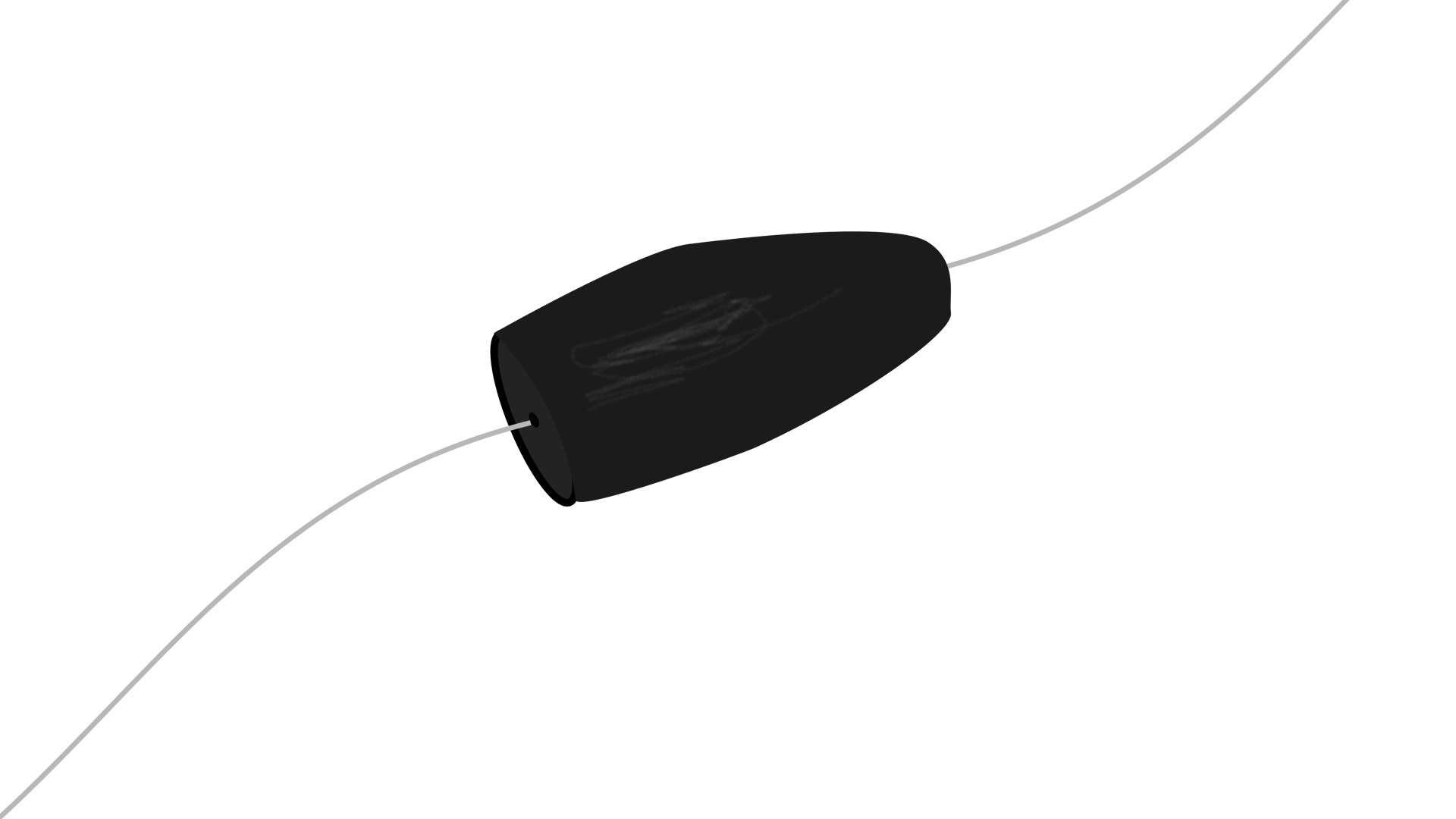Even though Texas rig bass fishing has been well known for 7 decades, it would be a mistake to think that it's old news. Here you'll find clear how and why answers to take advantage of this essential method.
Texas Rig Bass Fishing 101: Everything You Need To Know
We'll start with the basics and, along the way, work in some killer Pro tips. That combination of solid fundamentals and attention to key details is what makes this rig just as relevant today as when it was invented. The Texas rig (sometimes just written as T-rig) gives you a way to fish soft plastics into and through anything from light to heavy cover - with a very low risk of getting hung up. At the same time, the use of a soft plastic bait allows you to keep your fish hook-up ratio high.
Texas Rig Basics
Here's what the rig itself looks like:

To break it down in words, a free-sliding bullet sinker is threaded onto your line with the pointed end facing towards the "reel end" of the line. Then tie on a dedicated offset worm hook (described in the next section and pictured above, top-right) using a strong knot such as a Palomar. Finally, mount your soft plastic lure by pushing the hook point straight into the nose of the bait and then, maybe a quarter inch or less below that, poke the hook-point out of the side of the bait which you want to be the "belly side".
Finally thread the head of your bait all the way up around the "elbow bend" in the shank just behind the eye, twist the bait so that you can pass the point of the hook through the "belly" at a 90-degree angle and out the "back". When you've finished, the bait should lie perfectly straight and the hook point should lie flat along the top edge of the bait (with the apex of the hook bend occupying that 90-degree channel you made through the body of the bait). Many bass anglers like to skin-hook the back of the bait to help guarantee some extra weedless performance.
Pro Tip: You can also rig this without the weight for a super-natural, free-falling presentation.
Let's put some detail on those basics...
The Hook
Probably the most important element of Texas rig bass fishing is the hook itself. Using a specialised worm hook with that 90-degree elbow bend to hold the head of the bait in place is key to having the whole rig work. With a regular, straight shank hook (non "worm-hook" models), the bait will slide down towards the bend and not be held straight between the "elbow" and the bend. Not only that, but the hook-point will be sticking out of the bait at an angle pointing out, away from the eye. That spoils the weedless and snag-free performance.

Within those specialised worm hooks, you have straight-shank versions (bottom of picture; for narrower worm baits) and also the offset, Extra Wide Gap (EWG) models (top of picture; particularly good for thick creature baits).
The offset and curved-shank means that there is enough space to accommodate the body-width of chunky soft plastic baits and still have the hook point lay flat along the back side of the bait.
Pro Tip: For baits you want to get to the bottom/through cover quick - use heavier wire hooks. For baits you want to flutter down with more action, use lighter wire hooks and take advantage of the following sizing guidance:
- The fatter a bait is for its length, the more likely it will suit an EWG style (long, thin baits work great with straight shank worm hooks)
- For standard size craw/paddle-style creature baits, EWG hooks in the 3/0 to 4/0 range will be good choices
- For 6" finesse worms and regular senkos try 3/0 straight shank worm hooks
- For 7-8" worms go with 4/0 straight shank worm hooks
- Baits bigger than those already covered might need up to a 5/0 straight shank hook for long, thin baits and up to 5/0 EWG for flipping monster, fat baits into heavy cover
Pro Tip: if your hook brand/model doesn't have the point laying perfectly flat in line with the bait, use pliers to bend it out just the right amount to create a perfect weedless bait with great fish-hooking performance.
The Line
A safe, universal line for Texas rig bass fishing would be 15lb fluorocarbon, fished straight through from reel to hook. That's heavy enough to cope with a reasonable amount of cover and transparent enough to not stand out too much in clear water. Fluorocarbon lines should also be more abrasion resistant than braid.
For super finesse worm fishing and pressured bass, you might go as low as 6lb to 8lb fluorocarbon (but you'll obviously not be able to muscle out of snags to anything like the same degree). This is for threading a weedless bait through cover that is not too dense (primarily light growth of aquatic vegetation).
For chopping through grass and dense but soft vegetation (and where you don't expect to encounter any sharp edges at all), then braid between 35 and 50lb reel line to a fluorocarbon leader of 15 - 20lb is another way to go.

Bass Fishing while chopping through cover can be an essential way to fish creature baits and worms
Above all, the strength and material choice of your line relates to the cover density, sharp (braid-cutting) edges and whether the fish get the chance to be picky or not. Clearer water away from thicker cover points towards much more finesse, lighter fluorocarbon. Dense grass, abundant vegetation or thick brash/laydown cover removes much of the need for finesse and it's much more important to have strong line.
The Rod
Match the power of your rod to the type and density of cover you're fishing through and density of the bait you need to punch the hook-point through. With heavier cover and a more concealed hook-point on a fat bait, go to medium-heavy to heavy action rods. Fishing that dense cover also probably means you'll be using a heavier weights, which also makes sense with that rating.
For fishing light and shallow cover with finesse worms (and particularly weightless texas rigging with senkos) then medium or medium/light rods with a fast action and flexible tip give extra sensitivity along with better casting performance for the lightest weight rigs.
Now, before we get into some key features of the weight - and pro tips to choosing the right one - here are some more ways to stay one step ahead of the fish (and your fishing buddies):
Unfair Advantage Tactics...
You might be wondering how the most successful bass anglers manage to stay ahead of the pack. To help with that, I've pulled together some of my favourite "unfair advantage" knowledge and turned it into a free e-book as a subscriber bonus.
Just Click Here or on the Book Image/Button below to register for your Free Copy - PLUS 5 best "Fishing Expert Secrets" Email newsletters:

The Weight: Key ingredient to Texas rig bass fishing
While it's one of the simplest rigs in all of bass fishing, the choice of weight has a big impact on your success. The bullet weight has a number of key features that make it the ideal tool for the job. First of all, having a cone shaped weight means it tends to come through cover easily - which is important given the main aim of the rig is to fish every type of cover you might encounter.

Secondly, the ability of the weight to slip up the line away from the bait after you have twitched it creates a special action which is different from jig heads or other fixed weight presentations. Only in dense, deep cover (or when you have zero interest in fishing a bait as it falls) should you peg the weight close to the hook eye.
Being denser than lead, tungsten weights are smaller for the same masss - and therefore slip through fish holding cover more easily again. Given that ease is a major reason for having a bullet-shaped slip sinker in the first place, it's a good argument to go with tungsten if your budget allows.
Pro Tip: For soft plastic baits with a lot of inherent action (flapping claws, tails, paddles etc.), go with conical slip sinker options between 1/4 and 3/8-ounce sizes. This allows them to "work" much better during each fall phase following a twitch
Pro Tip: For baits with little inherent action that you need to get to the bottom right away, then 1/4 to 1/2 ounce is closer to the money
Pro Tip: For punching into much thicker cover, then tungsten sinkers between 1/2 to 1-ounce weights PEGGED just in front of the hook eye will get the job done right.
Pro Tip: For swimming Texas rigged plastics (see below), you need to match the weight to the depth in the water column you want to present your bait. This can be as light as 1/16-ounce for fishing shallow or maybe 5/8-ounce for swimming through deep water.
Pro Tip: Don't forget that, with baits like big senkos, the worm weight is more than enough to cast with and that allows a super-subtle, natural fall finesse presentation - so sometimes the most important role of a sinker is to NOT be there!
Texas Rigs Are Super Customizable
Plastic Worm
Now part of bass fishing folklore, the Texas rigged plastic worm is where the rig made its name - and really opened up fishing the thickest cover in a highly effective way for the first time. The use of wide gap hooks with that 90-degree angle "elbow" to rig a worm in a weedless fashion can even be used with things like drop shot rigs. Now, while that isn't strictly a Texas rig; it shows how useful and adaptable that hooking method and hook choice is across the board.
Soft Plastic Craws (and Other Creature Baits)
We've seen in the hook choices how going with a large EWG for creature baits lets you drop those enticing profiles and actions right in front of bass sitting in dense cover. This is fantastic for triggering a reaction strike as that easy meal falls right into a fish's face.
Plastic Flipping Tube: Oldschool Texas Rig Bass Fishing Secret Weapon
In bass fishing, it always pays if you can get a technique to work that has fallen out of favour or fashion with other anglers. Tubes are well known as fantastic smallmouth as well as largemouth bass lures. However, many anglers find them troublesome to fish with - and can experience poor hook-sets with these baits too. Bassmaster Elite Series Pro Bill Lowen has some excellent tips for how to use the Texas rig to get fish these baits to their full potential on the Bassmaster YouTube channel
Literal Pro Tips Summarised from the video:
Pro Tip: DON'T bury the eye of your hook inside the head of the tube (you need the head to sit down into the elbow on the hook to keep it from slipping back to the bend and balling up all the time)
Pro Tip: DON'T peg your weight unless you're fishing in the absolute thickest cover (you want it to separate out away from the tube as it sinks between each pop or twitch with the rod tip)
Pro Tip: DON'T Skin hook your tube or otherwise bury the hook point - you need the maximum chance of getting a great hook-hold when you're flipping tubes
Texas Rig Bass Fishing Presentation Techniques
Dragging Retrieve
The standard dragging retrieve involves making two to three foot sweeps with the rod and then gathering the slack (allowing the bait to pause on the bottom between drags). This can be a great approach when using craw worms, lizards and ribbon tail worms - anything with a good degree of action when lifted, pulled along and allowed to drop. It does also work when using simple worms with less action.
A variation on this, and one that can be particularly worth trying with soft stick baits like senkos is to move the bait along predictably with the reel. Bass fishing is about ringing the changes after all.
Dead Sticking
Surprisingly effective (generally in cold water) for presenting a worm on a drop shot rig (perhaps hooked Texas rig style for use in amongst cover). The "true" deadsticking method works great when Texas rig bass fishing too. This involves keeping your nerve by casting your bait out, pointing your rod at the rig and doing nothing but watch the line in case it flicks and draws away (your cue to set that wide gap hook with authority).
Variations that might still be allowed loosely under the term dead sticking include some gentle wiggling of the rod tip from side to side or up and down...but without retrieving any line or moving the worm off its spot on the bed.
Flip and Pitch
Often known as power fishing, this is efficiently hitting likely spots in cover using a variety of underhand (and roll or even skip) casts at relatively short range. Dropping the bait in quickly and as quietly as possible to fish in each pocket before burning it back in, ready to flip into the next spot.
Here's where reels with faster gear ratios can come in, even for what is quite a passive presentation (fishing the falling bait or popping it a few times on the bottom). You want to spend as little time out of our day as possible retrieving each cast before getting your bait back out into another spot.
Simple Swim
As mentioned in the section on types of weight, swimming a Texas-rigged soft-plastic bait is another of the effective fishing techniques you should try with this rig. Obviously, lures with inherent action such as curly tail worms, creature baits with flapping claws, soft swimbaits lend themselves to this method. But even straight worms and - particularly on a weightless T-rig - a fluke (soft jerkbait) can be great ways to fish through cover.
You can present your bait at any depth with this style - just match your weight (or lack of weight) to the depth you need it to swim at.
Texas Rig Bass Fishing Questions
So far in this article, you've already learned:
- How to Setup a Texas Rig
- How to Fish a Texas Rig for Bass
- How To Texas Rig A Worm
- Where to Fish a Texas Rig
Now for some quickfire answers to frequently asked questions on Texas rig bass fishing...
FAQ
Is a Texas rig good for bass?
Absolutely yes, it is one of the most versatile and effective bass fishing rigs ever devised. A Texas rig is often the key to being able to fish a range of soft-plastic baits in matted vegetation and all kinds of other cover like stumps, laydowns, grass and brush piles.
Which is better Texas rig or Carolina rig?
Each has strengths for particular bass fishing applications. The Carolina rig is a great way to be able to cast a long way and then still have a softly falling/wafting presentation of the bait. This is due to the greater separation of that bait from the weight that may be dragging along the bottom. It's an efficient way to cover lots of water, when you don't have to deal too much with snags.
Throwing accurately into cover is the strong suit of the Texas rig. For really dense cover you can even peg the weight to avoid tangles of the line strung between the weight and the lure when the sinker slides further from the bait. You will also get a different kind of fall with a T-rig; and this is suited to vertical presentations associated with flipping - and the highly erratic "pop and spiralling sink" presentation of plastic tubes.
What is a Texas rig good for?
Although designed originally for bass fishing, a Texas rig is good whenever you need to present a versatile range of soft baits into any kind of cover without getting snagged. It is equally good in shallow water or deep and it allows you to hop, twitch, drag or swim soft plastics of all designs in, around and through the kind of snags and vegetation that would be impossible with exposed-hook lures. The rest of this article explains how to do that with everything from a weightless bait all the way up to heavier sinkers, big baits and 5/0 hooks.
What weights to use for a Texas rig?
The advice in this article is to go for tungsten bullet-shaped slip sinkers - most often in the 1/4 to 3/8-ounce range for general fishing. Weights as heavy as 1/2 or even an ounce or more could be useful for punching into heavy vegetation cover.
Texas Rig Bass Fishing Round Up
So there you have it from fundamentals to expert tips - the rigs, gear, baits and tactics that make Texas rig bass fishing effective and fun. As it heads for its eighth decade of use, this is a rig that will be in fashion for a long time yet. Let me know in the comments if you have any questions or contributions to make and, in the meantime, I hope you can go out and get your rod bent somewhere soon.
Paul
